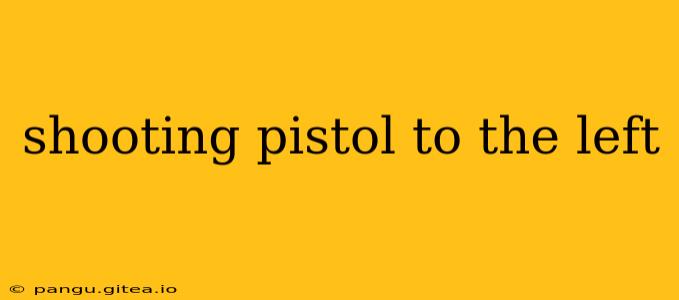Shooting a pistol is a skill that requires practice and precision, regardless of whether you're right- or left-handed. While many firearms are designed for right-handed shooters, left-handed individuals can effectively learn and master pistol shooting with the right techniques and adjustments. This guide explores the nuances of shooting a pistol left-handed, covering safety, stance, grip, and sighting.
Safety First: Prioritizing Safe Gun Handling
Before delving into the techniques, let's reiterate the paramount importance of gun safety. Always treat every firearm as if it were loaded. Follow the four basic rules of gun safety religiously:
- Treat all firearms as if they are loaded: This is the most crucial rule. Never assume a firearm is unloaded.
- Never point the muzzle at anything you are not willing to destroy: This prevents accidental discharges and injuries.
- Keep your finger off the trigger until your sights are on the target and you have made the decision to shoot: This prevents accidental discharges.
- Be sure of your target and what is beyond it: This prevents unintended harm to bystanders or property.
These rules apply equally to right-handed and left-handed shooters. Never compromise on safety.
Left-Handed Pistol Shooting Stance
A solid stance is fundamental to accurate shooting. The ideal left-handed stance mirrors the right-handed stance, but reversed. Here's a breakdown:
- Feet: Shoulder-width apart, with a slight angle to provide a stable base.
- Body: Maintain a relaxed yet firm posture, avoiding tension.
- Grip: A firm, consistent grip is crucial. We will discuss grip specifics further below.
Experiment to find a stance that feels comfortable and stable, allowing for controlled movements and accurate aiming.
Mastering the Left-Handed Grip
The grip is crucial for accuracy and control. A proper left-handed grip involves:
- High Hand Placement: Your left hand should grasp the pistol's grip firmly, with your thumb extending along the side of the slide.
- Strong Grip: Your grip should be firm but not tense. A death grip can hinder accuracy.
- Consistent Grip: Practice maintaining the same grip throughout each shooting session. Consistency leads to better accuracy.
Experiment with different grip pressures to find what best suits you, ensuring that you can maintain control without straining your hand.
Sighting and Aiming: Adapting for Left-Handed Shooters
Sighting is inherently the same regardless of handedness, but subtle adjustments might be necessary. Many find it comfortable to use the left eye for sighting, while others might prefer their right eye. This can also be influenced by the firearm's design.
- Dominant Eye: Identify your dominant eye—the one you naturally use for aiming. If your dominant eye is on your right, this might take some extra practice.
- Sight Picture: Maintain a consistent sight picture, focusing on the front sight.
- Trigger Control: Smooth and consistent trigger pull is essential, avoiding jerking or anticipating recoil.
Practice consistently to refine your sight picture and trigger control.
Choosing the Right Firearm
While many firearms are designed for right-handed shooters, some manufacturers offer ambidextrous models, or models that can easily be adapted for left-handed use. Consider researching specific firearm models that are designed to accommodate left-handed shooters for enhanced comfort and safety.
Conclusion: Practice Makes Perfect
Left-handed pistol shooting requires the same dedication to safety and practice as right-handed shooting. By understanding the specific techniques and adapting to individual needs, left-handed shooters can effectively learn and excel in this skill. Remember to always prioritize safety and practice regularly to build confidence and precision. Seek professional instruction from a qualified firearms instructor for personalized guidance and feedback.
